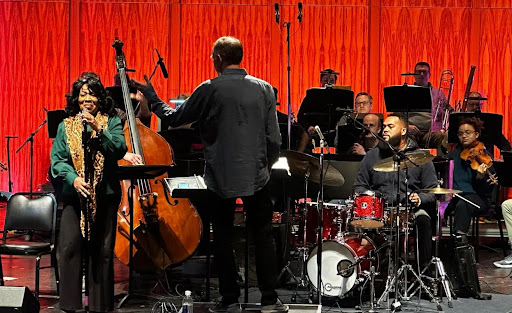by Peter Feher

Between the different instrumental configurations and the sheer variety of musical styles, there were what sounded like four distinct orchestras onstage Saturday night.
But the Akron Symphony came up with a pragmatic solution that made the performance possible. Music director Christopher Wilkins kept the ensemble small — scarcely more than 30 musicians for the biggest work of the evening. If the orchestra wasn’t exactly out in full force here, this tight-knit group of players nonetheless had all the power and finesse of a seasoned symphonic unit.
It also helped that each piece on the program had its own way of negotiating the chamber orchestra format.
There were moments in Jake Gunnar Walsh and Jon Sonnenberg’s Conflagration, the sweeping world premiere that concluded the concert, when no one was playing and yet the sound of a lush string section still filled the hall. This was thanks to the technology the composers had brought with them, a switchboard setup of electronic effects pedals manufactured by the Akron-based company EarthQuaker Devices.
Conflagration marks the Akron Symphony’s second collaboration with Walsh, Sonnenberg, and EarthQuaker (following 2022’s Confluence). As before, the composers stood at the front of the stage as soloists, deploying the effects in real time like DJs, mixing and processing the raw material from the orchestra behind them.
The electronics in Conflagration were subtler than what a DJ would have done, however. Sometimes, the layer of effects was audible, like in an extended solo for flutist Barbara O’Brien where the reverb on her instrument was cranked up to resemble a soaring bamboo flute. But more often, the technology simply augmented the ensemble, allowing 30 musicians to sound like 100, an illusion that was broken only when the orchestra stopped playing and the music continued ringing.
The Akron Symphony joined forces with a local jazz combo to open the concert’s second half. Pianist Theron Brown, bassist Bryan Thomas, and drummer Zaire Darden were the rhythm section in the starring role of Mary Lou Williams’ Zodiac Suite, with vocalist Evelyn Wright and saxophonist Chris Coles contributing solos to the selection of five movements presented Saturday.
Williams’ mid-20th-century experiment in fusing jazz and classical forms is still struggling to find the best venue for its musical expression almost 80 years later. Neither the full symphonic arrangement of the suite nor the chamber orchestra setting heard here seems to have caught on among audiences or performers — perhaps because there’s such a great recording of the piece in its piano-trio version (with the composer at the keyboard).
As wonderfully mellow as the movements “Taurus” and “Cancer” were with the Akron Symphony, the jazz musicians were most in their element with their encore, Wright leading just the combo in an up-tempo take on the tune A Beautiful Friendship.
The orchestra was in more familiar territory for the program’s first half, which paired the monastic stillness of Arvo Pärt’s Fratres with the high spirits of Mozart’s Symphony No. 29 in A. The simplicity of either composition could have left the ensemble exposed, but both works shone in those moments when the musicians played out.
Published on ClevelandClassical.com January 18, 2024.
Click here for a printable copy of this article



